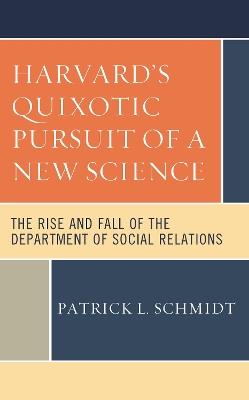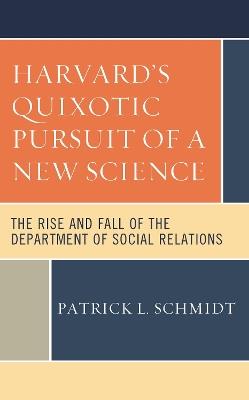L’articolo è stato aggiunto alla lista dei desideri
IBS.it, l'altro eCommerce
Harvard's Quixotic Pursuit of a New Science: The Rise and Fall of the Department of Social Relations
Cliccando su “Conferma” dichiari che il contenuto da te inserito è conforme alle Condizioni Generali d’Uso del Sito ed alle Linee Guida sui Contenuti Vietati. Puoi rileggere e modificare e successivamente confermare il tuo contenuto. Tra poche ore lo troverai online (in caso contrario verifica la conformità del contenuto alle policy del Sito).
Grazie per la tua recensione!
Tra poche ore la vedrai online (in caso contrario verifica la conformità del testo alle nostre linee guida). Dopo la pubblicazione per te +4 punti



Tutti i formati ed edizioni
Promo attive (0)
Harvard's Department of Social Relations and its audacious goal of creating a new science was a unique experiment in American academia, and its rise and fall is a little-known story. Among its faculty were some of the most eminent social scientists of the time, including some who became notorious for dubious research methods, such as Timothy Leary and Richard Alpert (reborn as Ram Dass), who haphazardly researched the effects of psilocybin on students, and Henry Murray, who traumatized undergraduate Ted Kaczynski (later the Unabomber) in a three-year long abusive psychological experiment. But the real story of the department is a fascinating instructive tale of hubris, ego, and academic politics overlaid on famed sociologist Talcott Parsons's obsessive quest for an all-encompassing theory of social behavior - the white whale to his Captain Ahab. The idea for Social Relations was hatched in the 1930s. Scorned by traditional interests in their Harvard departments, rising faculty stars in anthropology, sociology and psychology fled their oppressors, seeking to create not merely a new department but a new social science. The refugees were Talcott Parsons, Gordon Allport, Henry Murray, and Clyde Kluckhohn. They promised an interdisciplinary science that would supplant the elder social sciences of history, government, and economics in its ability to explain human behavior. An audacious aspiration, critics found it as imperious as it was implausible. Inspired by the new and controversial works of Sigmund Freud, Carl Jung, Max Weber and Emile Durkheim, the group met clandestinely to plot the bold venture, giving their efforts a conspiratorial air. They called themselves the "Levellers" in recognition of the many levels they believed the study of behavior required. Their big break came when their vision was legitimized by interdisciplinary research during World War II by the Research Branch of the War Department and the Foreign Morale Analysis Division of the Office of War Information. Government agencies employed teams of clinical and social psychologists, cultural anthropologists, and sociologists to study issues important to the war effort, such as assessing the morale of the Japanese, as well as the spirit of our own troops. Twenty-five years later, some at Harvard referred to it facetiously as the Department of "Residual" Relations. The grand experiment had run its course. Failing in its early years to develop a unified theoretical foundation, Social Relations was unwieldy, more multidisciplinary than interdisciplinary. It became a three-ring circus with distinct acts from psychology, sociology, and anthropology. After an early burst of enthusiasm from faculty and graduate students to create a new discipline, hopes faded. The single most ambitious attempt to integrate its component disciplines, the Carnegie Project on Theory and its work product, Toward a General Theory of Action, missed the mark. Without an integrated theory, the department failed to create "social relations" as a new science. The saga engendered controversies that became national, even international, scandals. From the psilocybin "research" of Timothy Leary and Richard Alpert to the infiltration of the teaching staff of the department's (and one of Harvard's) largest courses by the radical Students for a Democratic Society, fierce arguments raged about what was a proper subject or method of inquiry and just how far academic freedom should extend.
L'articolo è stato aggiunto al carrello
L’articolo è stato aggiunto alla lista dei desideri



